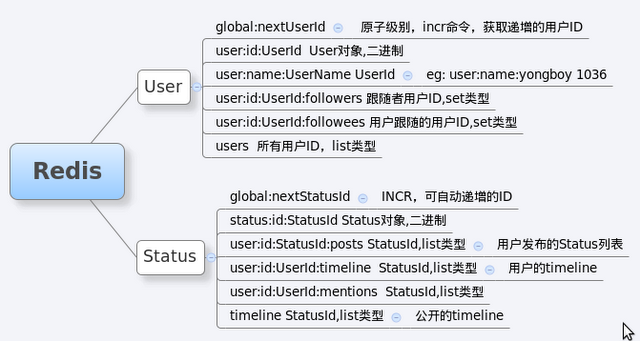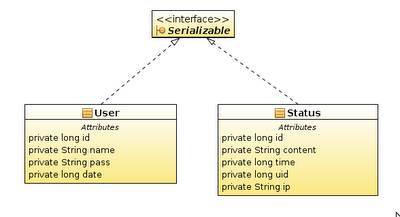Servlet 3.0筆記之Redis操作示范Retwis JAVA版
最近學習Redis,一個目前風頭正勁的KEY-VALUE NOSQL,支持LIST、SET、MAP等格式存儲,某些操作竟然是原子級別,比如incr命令,相當驚艷。官方提供的一個Retwis(simple clone of Twitter)示范,證明了完全可以使用redis替代SQL數據庫存儲數據,真是一大開創性創新,挑戰人們的傳統思維模式,為之驚嘆!
不過那是一個PHP版本,我下載到本地PHP但無法部署成功;還好有一個Retwis-RB示范,還提供一個在線版,試用之后,再下載源代碼,RUBY + Sinatra MVC結構,看的流口水,代碼那般簡潔。
為體驗Redis,同時也為對比Ruby代碼,因此誕生了Retwis-JAVA,Retwis-RB的山寨版,因此其邏輯和HTML資源一致,再次表示對原作者Dan Lucraft的感謝。
Retwis-JAVA,基于Servlet 3.0 + UrlRewrite + Freemarker + Jedis。示范運行在Tomcat 7中,redis為最新的2.22版本,jedis為redis的java客戶端操作框架。在Servlet 3.0規范中,對Url映射處理依然沒有進步,因此只能使用UrlRewrite框架讓部分url看起來友好一些。另外,項目沒有使用IOC容器框架,沒有使用MVC框架,代碼量稍微多些,代碼相對耦合一些。若使用Struts2 + Spring 代碼量會少一些。
對涉及到的redis存儲結構,大致如下:
涉及到的兩個對象很簡單:
序列化后以二進制數據保存到redis中:
if (value == null)
return null;
ByteArrayOutputStream arrayOutputStream = new ByteArrayOutputStream();
ObjectOutputStream outputStream;
try {
outputStream = new ObjectOutputStream(arrayOutputStream);
outputStream.writeObject(value);
} catch (IOException e) {
e.printStackTrace();
} finally {
try {
arrayOutputStream.close();
} catch (IOException e) {
e.printStackTrace();
}
}
return arrayOutputStream.toByteArray();
}
public void save(String key, V value) {
jedis.set(getKey(key), object2Bytes(value));
}
獲取用戶的timeline時,redis的LRANGE命令提供對list類型數據提供分頁操作:
if (page < 1)
page = 1;
int startIndex = (page - 1) * 10;
int endIndex = page * 10;
List<String> idList = super.jedis
.lrange(targetId, startIndex, endIndex);
if (idList.isEmpty())
return new ArrayList<Status>(0);
List<Status> statusList = new ArrayList<Status>(idList.size());
for (String id : idList) {
Status status = load(Long.valueOf(id));
if (status == null)
continue;
status.setUser(userService.load(status.getUid()));
statusList.add(status);
}
return statusList;
}
很顯然,LRANGE取出了Status對象的ID,然后我們需要再次根據ID獲取對應的Status對象二進制數據,然后反序列化:
return super.get(getFormatId(id));
}
private String getFormatId(long id) {
return String.format(STATUS_ID_FORMAT, id);
}
private static final String STATUS_ID_FORMAT = "status:id:%d";
public V get(String key) {
return byte2Object(jedis.get(getKey(key)));
}
@SuppressWarnings("unchecked")
private V byte2Object(byte[] bytes) {
if (bytes == null || bytes.length == 0)
return null;
try {
ObjectInputStream inputStream;
inputStream = new ObjectInputStream(new ByteArrayInputStream(bytes));
Object obj = inputStream.readObject();
return (V) obj;
} catch (IOException e) {
e.printStackTrace();
} catch (ClassNotFoundException e) {
e.printStackTrace();
}
return null;
}
以上使用JDK內置的序列化支持;更多序列化,可參考hessian、google protobuf等序列化框架,后者提供業界更為成熟的跨平臺、更為高效的序列化方案。更多代碼請參見附件。
一些總結和思考:
- 不僅僅是緩存,替代SQL數據庫已完全成為可能,更高效,更經濟;雖然只是打開了一扇小的窗戶,但說不準以后人們會把大門打開。
- 實際環境中,可能最佳方式為SQL + NOSQL配合使用,互相彌補不足;還好,redis指令不算多,可速查,簡單易記。
- JAVA和RUBY代碼相比,有些重
另:
在線版,請參考 http://retwisrb.danlucraft.com/。那個誰誰,要運行范例,保證redis運行才行。
參考資料:
Writing a simple Twitter clone with PHP and Redis
posted on 2011-04-06 09:42 nieyong 閱讀(6135) 評論(0) 編輯 收藏 所屬分類: Servlet3





